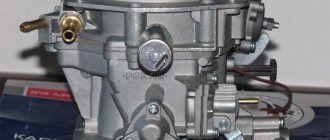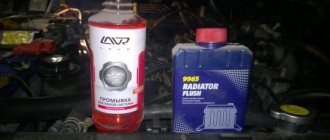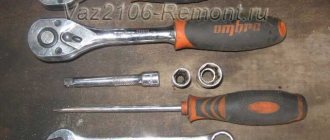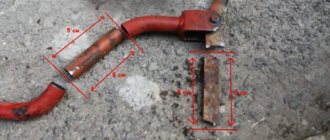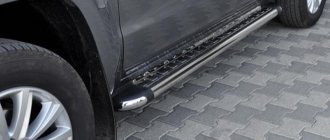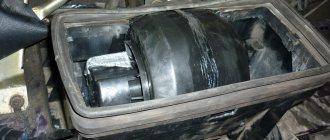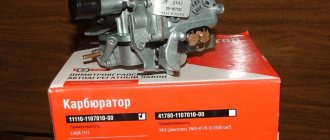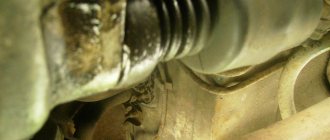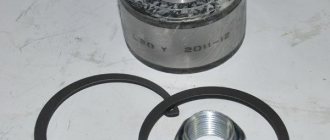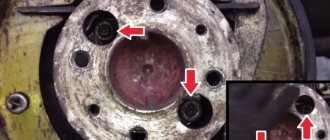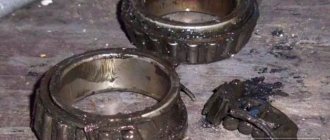A carefully polished car interior instantly creates an impression of the well-groomed and cleanliness of its owner. A dirty and tattered interior of a car creates the opposite feeling of disgust towards the owner... Therefore, every motorist who respects himself and his fellow travelers is obliged to keep them in order "iron horse": either, with the help of professional craftsmen, he carries out repairs to the car interior with his own hands, and we will tell you how to do this below.
Proven in practice! Correcting even minor defects inside a car’s interior increases its value by 10-20% when selling to another car owner.
Main causes of wear:
1. When driving a car for a long time, parts quickly wear out from contact with passengers and the driver himself:
- Leather seats and steering wheel are subject to mechanical friction.
- The interior trim becomes covered with a coating of dust, smoke and dirt.
- Plastic coated surfaces are scratched.
2. The condition of the car interior is affected by external weather conditions:
- Low and high temperature differences.
- Ultraviolet healing.
3. An accident is the most destructive cause, as it leads to severe damage to the interior.
Selection of the necessary tools
If you have never repaired anything and did not have time to purchase a tool, do not despair - at the nearest car market you will be offered a variety of professional kits, and at a good price. And this price will be influenced by the number of tools in the set and its manufacturer. The main thing is that the kit is equipped with devices that will help with dismantling parts and the interior trim itself, removing the car radio, door cards, moldings and instrument panel parts.
It is better to choose polyurethane dismantling blades. This will help not cause as much damage to the plastic parts of the interior. Nothing will work if the kit does not contain keys for removing the climate control and a fork for removing the pistons. Don't worry about the problem of where to put the set after repair. It will be useful to you a hundred times again. You will also be pleased with the versatility of the tools, because they are suitable for repairing the interior of any car model.
Where should you start restoring the interior?
So, let’s begin the process of restoring the car’s interior with our own hands. First you need to clean the inside of the car, that is, thoroughly wash off the dust and dirt. Next, conduct a thorough inspection of all interior parts for any imperfections. To eliminate all defects, you need to do them one by one. Look around your salon and identify key local points for restoration.
If you have a leather interior , we recommend reading our material on the repair and restoration of a leather car interior
Video
If there are a lot of scratches, then the technology of re-covering the damaged areas with leather is used. The plastic element is removed in advance, dimensions are taken from it, and then the atelier is given the opportunity to sew covers for the part. As a result of all the work, the part is mounted back. The method of polishing and heating is also recommended. Rarely, there are cracks in plastic that can be repaired by gluing.
Do-it-yourself plastic repair in the car interior
The process of restoring the plastic of a car interior consists of a certain sequence that must be strictly followed.
- Plastic areas with defects are filled with a special polymer mixture, which can be bought at a car store (for example, “around the corner”).
- It is necessary to reproduce the unique pattern of the damaged item. This is done very easily - apply the gel solution to the area nearby and after polymerization of the solution, an impression of the texture will be ready. This pattern must be re-shot onto the defective part before the special mixture completely hardens.
- Coat the repaired part with paint.
Instructional video on plastic repair:
DIY torpedo repair
A torpedo is a panel with control instruments. It is made from high-density plastic and, in case of damage, can be repainted or covered with polyvinyl chloride film, the advantage of which is excellent wear resistance.
Door plastic repair
Plastic for door trim is more popular because, compared to leather and fabric, it is easy to clean and serves its owner longer. To repair the plastic on the doors, you need a plasticizer gel, which fills the recesses and cracks in the door trim.
Painting plastic
To do this, first of all you need:
- Select the color of the paint according to the layout number.
- Mix the pigments according to the formula and add water.
- To test, apply a little to make sure the shade is correct.
Preparing for painting
It is important to sand the plastic surface well with a utility knife, removing sharp corners and burrs and ideally “smoothing” the area. Also clean the entire perimeter of any bulging, protruding pieces. Next, you need to go over it with an abrasive sponge, but be careful as you cannot touch undamaged plastic. Finally, the entire surface is thoroughly wiped with a dry cloth and areas not to be repaired are masked with masking tape.
The process of painting plastic parts
The damaged area of the plastic surface is painted in 4-5 layers of prepared paint. Be sure to maintain an interval of 10 minutes between layers at 22-25 degrees. If after five applications the result is unsatisfactory, then it is quite possible to paint it a couple more times. The result should please the eye like a “brilliant fifty dollars.”
Important! The painted plastic can be used after 24 hours.
Preliminary work
First of all, the interior of the machine should be thoroughly cleaned of dirt and dust. Next, the interior needs to be carefully examined for any deficiencies. Quite often, the process of identifying interior defects convinces the car owner that the interior of his vehicle needs a comprehensive repair. That is why a car enthusiast can imagine the full scope of repair work and make an approximate estimate of upcoming costs only after completing these steps.
Car seat reupholstery technology
Car seat repair is one of the most popular services in professional workshops, since this part of the car is not wear-resistant and is subject to friction every day. But its restoration can be easily done by the owner himself. Depending on the material, the banner is divided into two types:
- Local seat reupholstery. It does not require the removal of seats; restoration is done in the literal sense of the word “at the scene of the incident.”
- Full seat reupholstery. Forces you to remove the seats from the car.
Seat upholstery repair
With the above local reupholstery, they are treated with a special chemical mixture, which can be applied to fill small cuts, cracks and holes in the seat upholstery. With local reupholstery, all seats are removed from the car and the upholstery is removed. Accurate measurements are taken taking into account the configuration and patterns are created for sewing new “clothes”.
Seat foam repair
When completely reupholstering the upholstery, you can immediately replace the filler that has become unusable - foam rubber, since it also crumbles heavily over time and does not hold its shape when deformed. If desired, you can slightly change the geometric shape of these parts to suit the individual preferences of the owner.
Possible damage
Direct sunlight and excessive heat will dry out leather trim. It dries out, cracks, and tears.
The most common defects in leather upholstery:
- punctures;
- burns;
- cuts;
- spots;
- ingrained dust;
- ruptures;
- abrasions;
- scratches;
- loss of color;
- cracks.
Fixable upholstery problems are caused by the leather losing its elasticity due to drying out.
Car leather interior repair
Making it yourself is not that difficult. Liquid leather is used for minor cuts and tears. For larger defects, you need to apply a patch, wait until the glue dries and begin to carefully apply liquid leather. To make the surface dry faster, you can use a heating hairdryer and then sand it so that the patch is not felt during tactile contact.
For more information about the repair of leather seats and the interior in general, read our material at the link:
Stage 1: selection of materials
The standard of beauty and luxury is leather. This coating is distinguished by its noble design, aesthetic appeal and durability. The disadvantage of this material is its excessively high price. The modern market offers huge variability when choosing interior coatings, which are much cheaper than leather, and are almost in no way inferior to it in appearance.
- Carpet . The most common artificial material. It is usually combined with various pile and fabric coverings. The main advantages of the product are ease of installation and great variability in color design.
- Alcantara. The material has a fabric base and is a product of the textile industry. Products made from this fabric are durable, have a pleasant velvety surface to the touch, and a special protective film effectively repels dirt. The coating is replete with an abundance of soft fibers of a certain direction. With prolonged mechanical action, over time, a characteristic imprint remains on such a surface. This is the only important drawback of the material.
- Leatherettes. The oldest material on the market, the priority goal of which is to accurately imitate natural leather covering. The product is quite practical, but at the same time it has considerable flaws. An unpleasant leatherette aroma, low moisture protection and mechanical strength are serious disadvantages of the material.
Restoring the interior ceiling
This procedure is often necessary due to smoking drivers and passengers, since tobacco smoke accumulates in the cabin and settles on the fabric and leads to the appearance of brown spots. It’s easy to solve this problem yourself:
- It is necessary to dismantle the fastening elements.
- Turn off all lamps.
- Remove the decorative trim panels.
- Remove the fabric and use it to make a pattern.
- Using the pattern, prepare new upholstery and stretch it, cut the necessary holes and return the above fittings to their place.
As you can see, it is quite possible to repair your “iron pet” yourself, the main thing is to have the desire and patience. We hope our article was useful to you.
Creating a pattern and sewing new upholstery
- If the old upholstery is not stretched, then it can be used as a template. To do this, it is ripped apart at the seams into its component parts. Before disassembling the old upholstery into parts, you need to make notes on each part, where it comes from, which part is adjacent to what. Each piece is placed on new material and a weight is placed on it so that it fits tightly. Next, part of the old upholstery is outlined along the edge.
- When outlining old upholstery, if the new material is face down, then the old upholstery must be face down, otherwise you will end up with a mirror image of the old upholstery, which will only be suitable for sewing with the back side facing out.
- You can first make templates from cardboard or thick paper so that you can use them to cut out parts for the new upholstery from the new material.
- Each new piece of upholstery also needs to be marked which part of the upholstery it belongs to and which edge is adjacent to what. The marks help to align the stitched parts evenly. Some materials can stretch from edge to edge, corner to corner. The marks help control the tension along the seam when sewing.
- You can make small cutouts at the marks. This way the marks will be visible from the front side. Marks/cuts are especially important on curved edges.
- When all the parts of the upholstery from the new fabric have been cut out and the soft backing has been glued and sewn, they need to be sewn together using a sewing machine. Use the correct needle and thread depending on the upholstery material you choose.
- Old upholstery will serve as a good hint for creating new one. Study how the seams were made, with what allowance, and reproduce them on the new upholstery.
- The seam allowance (the distance from the edge to the seam line) can be controlled using the sewing machine, and you can also mark the seam line before sewing. Marking the seam line allows you to better concentrate on the seam itself while sewing, without being distracted by special marks on the sewing machine.
Masking tape pasted at the required distance from the needle makes it easier to control the required seam allowance (distance from the edge to the seam) and make an even seam.
- Start by sewing simpler upholstery from the headrest or armrest. Already at this stage experience will be gained.
- Pile material has directionality. The direction of the pile is usually indicated on the back of this material with an arrow. If you run your hand over such material in the direction indicated by the arrow, the pile will smooth out. If you do this in the opposite direction, the pile will “rise.” Incorrect orientation of parts of such material relative to each other can cause a difference in shade. When installing such material on panels, the direction of the pile should be downward (the arrow will point down the panel). On seats, the backrest pile should “look” down, towards the seat itself. On the seat, the pile should be located towards the back of it.
What is film used for?
It’s logical to start with the reasons why motorists are drawn to buy vinyl film and wrap it around their car. Not everyone fully understands why this is done and what such a procedure ultimately achieves.
It’s worth starting with the fact that covering a car with film is much easier and cheaper than repainting it.
The film has been available on the market for several years. At first, pasting was carried out only in car services. Then car enthusiasts realized that there was nothing complicated here. The material itself has been improved, the range has expanded, and the quality has improved.
Vinyl films are somewhat reminiscent of plastic in their texture and structure. When heated, the material becomes elastic, and after cooling it hardens.
Typically, when using vinyl, the following purposes are pursued:
- improving the appearance of the car;
- protection of body paint;
- masking existing defects on a car.
Unlike coloring, gluing technology is simpler and more accessible. Therefore, this option for improving, hiding flaws and protecting paintwork remains extremely popular and popular.
Additional recommendations
To obtain a thick and even coating, only high-quality paints should be used. Experts recommend buying products in spray bottles. As a result, the consumption of substances will be reduced. Work should be performed with gloves and closed clothing to avoid contact with unprotected areas of the skin.
Important: The optimal distance from the surface when spraying is 25-30 cm. Following this rule, do not leave stripes on the ground.
The products are easy to use, so if you want to improve the condition of your car's interior, you don't have to go to car repair shops and overpay. You just need to choose an effective measure, without saving too much and allocate some free time. And you're done! Your car's interior looks like new again!
Conceal stains with a specialized pencil
If the defects are minor, you can use a special pencil. When purchasing it, you need to choose the color as accurately as possible. If the shade is even slightly different, then, of course, you will get rid of the scratch, but instead, stripes will appear on the surface of the torpedo.
The principle of operation of such a pencil is very simple - inside a small bottle there is a rather thick coloring composition that fills the crack and dries, thereby completely leveling the surface.
To use a marker, just wipe the surface from dirt and dust and, pressing on the pencil, squeeze the “putty” into the recess. It is recommended to remove excess composition and polish the surface.
Despite the simplicity of this method, it is worth considering the rather high cost of the pencil. However, this product can be reused.
If the damage is quite deep, then there are several other ways to repair the surface.
